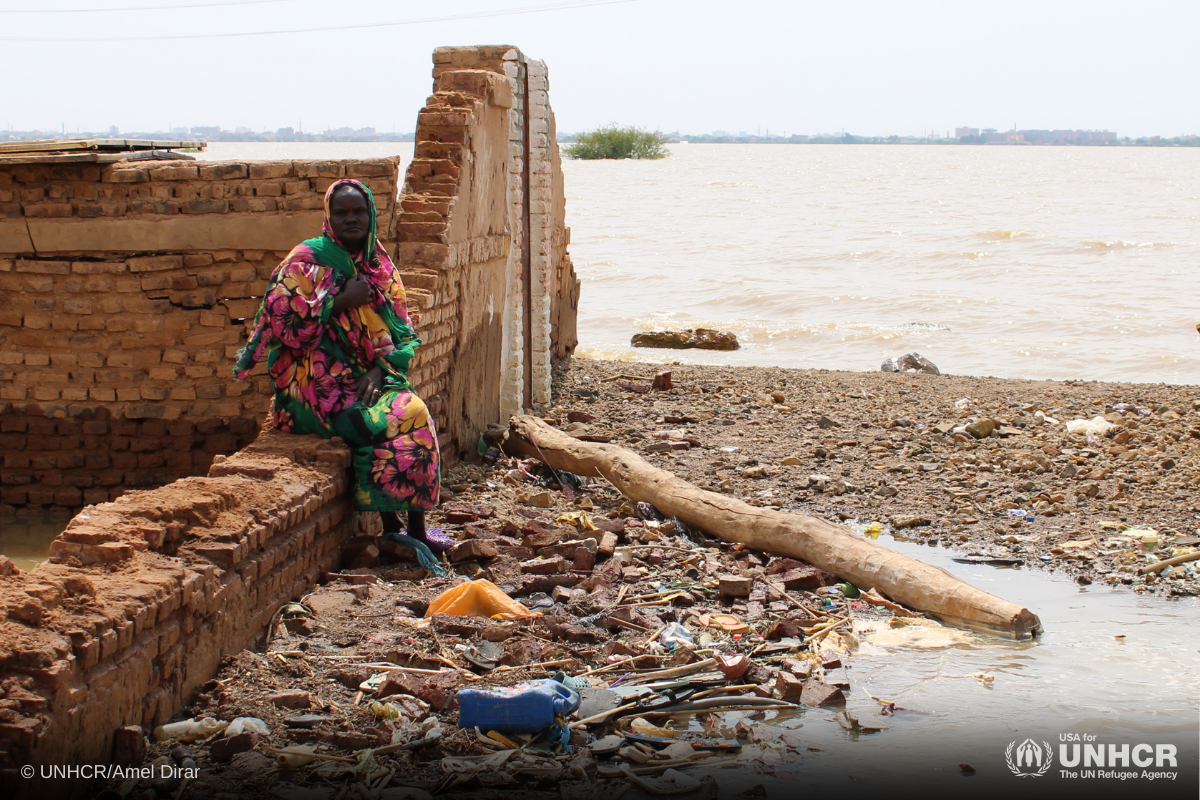Climate Change Is Forcing Millions to Flee—But Refugees Are Still Left Out of the Conversation

In 2023 alone, over 32 million people were displaced by climate-related disasters—more than those displaced by war and conflict combined.[1] While this statistic captures the scale of the crisis, it obscures some of the populations most at risk: refugees and stateless communities, who often live on the frontlines of environmental degradation and have the least protection under international law.
The global refugee population—now surpassing 36.4 million people—is disproportionately affected by climate change as they are systematically excluded from the resources and infrastructure needed to withstand it.[2] In many cases, they are settled in climate-vulnerable areas: flood zones in Cox’s Bazar, drought-prone regions in Chad, or overheated desert camps in Jordan. These sites are not only environmentally fragile, but also politically and economically marginalized, making them acutely susceptible to the effects of rising temperatures, resource scarcity, and extreme weather. In Cox’s Bazar, nearly one million Rohingya refugees live in precarious shelters on eroded hillsides, where monsoon floods and landslides are an annual threat. In Chad, prolonged drought and diminishing water supplies have intensified tensions between refugee and host communities. And in Jordan, desert-based camps face relentless heat, limited infrastructure, and growing pressure on depleting aquifers. Across these contexts, the absence of stable housing, reliable sanitation, and sustainable energy systems turns even minor climate stressors into existential threats.[3]
In Jordan’s Zaatari camp, home to nearly 80,000 Syrian refugees, summer temperatures routinely top 104°F (40°C), while groundwater depletion and infrastructural limitations exacerbate water scarcity.[4] In fact, much of the Middle East and North Africa (MENA) region could face lethal heat waves by 2100 if carbon emissions continue at current rates, compounding the risk of mass displacement.[5] Refugees—already displaced once by conflict, human rights violations, hunger and poverty, or climate change and natural disasters—could be forced to flee again, with nowhere to go and no legal framework recognizing their status. While often referred to as “climate refugees” in public discourse, this category remains undefined under international refugee law.
This global legal blind spot is not an oversight—it’s a failure of political will. The 1951 Refugee Convention protects those fleeing persecution based on race, religion, or nationality, but it does not include environmental causes. As a result, people fleeing climate-related disasters—whether sudden events like hurricanes or slow-onset crises like desertification—are not eligible for refugee status under international law, even if returning home would be impossible. These forms of displacement often affect communities in different ways: sudden disasters can trigger mass evacuations and emergency responses, while slow-onset changes may erode livelihoods over time, forcing migration that is less visible but no less urgent. In both cases, there is no guaranteed access to asylum, resettlement, or humanitarian aid.
Yet the scientific consensus is clear: climate change is not just a threat multiplier—it is a displacement driver in its own right.[6] Rising temperatures are already fueling food insecurity, disease outbreaks, and water scarcity across the Global South, with low-income and forcibly displaced populations bearing the brunt.[7] In East Africa, the worst drought in 40 years has displaced over 2.3 million people in Somalia alone, collapsing livelihoods and increasing conflict over dwindling resources.[8]
The intersection of climate and migration also reveals deeper inequities. The world’s poorest countries—many of which host the largest numbers of refugees—are responsible for less than 10% of global greenhouse gas emissions.[9] Meanwhile, the wealthiest countries, who have contributed most to climate change, are simultaneously slashing refugee admissions and building fortified borders. Climate adaptation funding, aimed at helping communities and nations build resilience to the impacts of climate change, often fails to reach refugees, who are frequently excluded from national development plans and have limited access to international climate finance mechanisms such as the Green Climate Fund (GCF).[10]
Efforts to address this gap remain piecemeal. Some countries, such as Argentina and Finland, have experimented with humanitarian visas for people fleeing climate-related disasters.[11],[12] The United Nations Human Rights Committee (UNHRC) has also ruled that countries may not deport individuals to places where climate change poses a threat to their life.[13] But these developments are non-binding and far from universal.
A fundamental shift in how the international community defines—and responds to—displacement is critical. First, global policymakers, legal bodies, and donor governments must recognize climate-induced displacement as a legitimate form of forced migration and extend legal protections accordingly. This requires updating international refugee frameworks and encouraging national governments to create pathways for climate-affected populations.
Second, climate adaptation strategies must include refugees—not as an afterthought, but as active participants. That means involving displaced communities in decision-making, channeling climate finance to refugee-hosting regions, and investing in context-specific resilient infrastructure. Examples include solar-powered water systems in Jordan’s Azraq camp, which supply clean water using renewable energy, or flood-resistant shelters in Cox’s Bazar, designed by UNHCR and partners to withstand seasonal monsoons.[14],[15] Early warning systems, such as mobile-based disaster alerts piloted in Uganda’s refugee settlements, have also helped improve preparedness for flash floods and landslides[16]. Support for sustainable livelihoods is equally critical: initiatives like the IKEA Foundation’s renewable energy training for refugees in Kenya’s Kakuma camp show how climate adaptation and economic inclusion can be mutually reinforcing.[17] These models are scalable—but only if displaced populations are recognized as stakeholders in both national and global climate strategies.
Third, high-income countries—particularly members of the OECD such as the United States, Canada, Germany, France, Australia, and Japan—must be held accountable for their disproportionate contribution to global emissions and the cascading effects of climate-related displacement.[18] This responsibility includes increasing funding toward climate reparations, including the recently operationalized Loss and Damage Fund established under the UNFCCC at COP28 to support countries most affected by climate-induced loss[19]; expanding refugee resettlement quotas to accommodate people displaced by environmental disasters, as urged by UNHCR and the International Organization for Migration[20]; and enforcing binding carbon reduction targets in line with the Paris Agreement’s 1.5°C pathway, particularly among the world’s top historical emitters.[21] These measures are not merely aspirational—they are increasingly seen as necessary to ensure global stability and climate justice, especially as the lines between refugee, climate migrant, and citizen continue to blur. And while the legal definitions may remain contested, the human cost will be unmistakable—in overcrowded camps, along fortified borders, and across communities already fractured by conflict, poverty, and environmental stress.
[1] Internal Displacement Monitoring Centre. Global Report on Internal Displacement 2024.
[2] UNHCR. Global Trends: Forced Displacement in 2023. United Nations High Commissioner for Refugees.
[3] UNHCR. (2023). Climate change and displacement: Impacts, responses and the role of UNHCR. United Nations High Commissioner for Refugees.
[4] UNHCR Jordan. Water and Climate Challenges in Za’atari Camp, 2022.
[5] 4. Lelieveld, J. et al. (2016). “Strongly increasing heat extremes in the Middle East and North Africa.” Nature Climate Change, 6, 199–204.
[6] McAuliffe, M., & Triandafyllidou, A. (2021). Word migration report 2022.
[7] Romanello, M. et al. (2023). “The 2023 report of the Lancet Countdown on health and climate change.” The Lancet, 402(10397), 2343-2397.
[8] UN OCHA Somalia. Drought Displacement Monitoring Dashboard, 2023.
[9] World Bank. Reducing Inequality in a Carbon-Constrained World, 2021.
[10] UNHCR. (2022). Displaced on the frontlines of the climate emergency. United Nations High Commissioner for Refugees. https://www.unhcr.org/climate-change
[11] https://humanrightsfirst.org/wp-content/uploads/2022/11/HumanRightsFirstOHCHRClimateChangeDisplacement.pdf
[12] https://www.unhcr.org/neu/wp-content/uploads/sites/15/2023/04/UNHCR-recommendations-to-Finland-on-strengthening-refugee-protection-April-2023.pdf
[13] https://www.refworld.org/jurisprudence/caselaw/hrc/2020/en/123128
[14] UNHCR (2017). Jordan's Azraq becomes world's first clean energy refugee camp. https://www.unhcr.org/uk/news/stories/jordans-azraq-becomes-worlds-first-clean-energy-refugee-camp
[15] UNHCR (2022). Protecting Rohingya refugees and building monsoon resilience. https://www.unhcr.org/neu/82857-protecting-rohingya-refugees-and-building-monsoon-resilience.html
[16] https://reliefweb.int/report/world/using-mobile-phone-technologies-disaster-risk-management-reflections-shear-june-2021
[17] https://www.unhcr.org/ke/11580-unhcr-kakuma-operation-hosts-ms-annelies-withhofs-ikea-foundation.html
[18] World Inequality Database (2023). Climate Inequality Report. https://wid.world/www-site/uploads/2023/01/CBV2023-ClimateInequalityReport-2.pdf
[19] United Nations Climate Change (2023). Fund for responding to Loss and Damage. https://unfccc.int/loss-and-damage-fund-joint-interim-secretariat
[20] UN Migration IOM. Institutional Strategy on Migration, Environment, and Climate Change 2021-2030. https://publications.iom.int/books/institutional-strategy-migration-environment-and-climate-change-2021-2030
[21] Romanello, M. et al. (2023). “The 2023 report of the Lancet Countdown on health and climate change.” The Lancet, 402(10397), 2343–2397.
